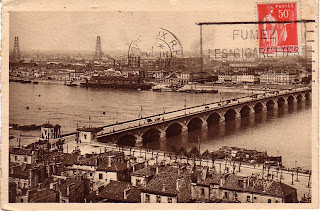 |
| A 19th century engraving of the Pont de Pierre. |
Throughout Bordeaux's long history there wasn't much need for a permanent river crossing. The city's development was confined to the left bank of the Garonne River where the deep water allowed large ships to dock. In contrast, the right bank remained largely agricultural -- planted with grape vines -- until the mid-19th century. For hundreds of years barges and rafts were the only means of transportation from one side to the other.
That was the situation when Napoleon arrived
at Bordeaux in 1807 on his way to war in Spain. Lack of a permanent structure meant that his 350,000 troops had to be
ferried across the Garonne. Now wait -- before you read any further just think about
that for a minute. A city of men, horses, tents, provisions, livestock, military supplies, and all of the artillery necessary for
waging a war, loaded onto wooden barges, carried across the turbulent Garonne, and unloaded on the opposite bank. This must
have been an enormous undertaking, and although I haven't found any description
of how it was accomplished, or how long it took, I'm willing to bet that the feisty
little Emperor wasn't too happy with the situation. It's not surprising that he
ordered the immediate construction of a permanent river crossing.
Because the construction of a masonry bridge in the Garonne was thought to be impossible Napoleon's first bridge was designed in wood. Work on the pilings began in 1812, but it
soon became apparent that the timber required wasn't locally available and finding adequate supplies would be a problem. The following year a flood destroyed much of the supporting scaffold and a large part of the completed work, delaying the project. In 1814 English troops entered Bordeaux on their march to Paris, the Empire fell, Napoleon
abdicated and work on the bridge stopped completely.
Two years later a group of Bordeaux's wealthy businessmen devised a plan to provide 2 million francs to restart
construction in exchange for the right to levy a toll on all
users for a 99-year period. The State
agreed to the proposal and construction work began again. Redesigned with stone supports and 17 brick arches (the
story is that there was one arch for each letter of the name Napoleon Bonaparte but I have a hard time envisioning any engineer making that a criteria for design), the bridge was
finally completed in 1822. Because of the treacherous conditions in the Garonne,
a diving bell imported from England was used in constructing the stone
piers. Although officially named the Pont Napoleon, locals have always referred
to it simply as le Pont de Pierre, the
stone bridge.
For nearly 150 years this remained the only way for vehicles
to cross the river. Complaints about the narrowness of the bridge were frequent and by the 1930s traffic jams were common. In 1941 the city voted to demolish le pont and construct a new crossing,
higher and wider than the original. The economic situation of the war years put a stop to the plan, surely one of the few positive aspects of WWII. In 1954 the bridge was widened from 15 meters to 20 meters, a move that saved the structure, although the tollbooths at either end were sacrificed to the march of time.
 |
| A view of the bridge shortly after construction was completed. Note the temple-like toll booths at the entry. |
In 1978 a large section of a similar stone bridge in Tours
collapsed, alarming the citizens of Bordeaux and alerting them to potential problems with their own structure. Intensive studies revealed that
the Pont de Pierre was sinking and a long period of restoration began. The
bridge, recently modified to carry the new tram line in addition to automobiles, is now constantly monitored from the cavities within the masonry piers.
Today the Pont de Pierre, so close to demolition 70 years ago, has become a symbol of Bordeaux and is one of her most treasured landmarks. Therein lies the value of historic preservation.
Today the Pont de Pierre, so close to demolition 70 years ago, has become a symbol of Bordeaux and is one of her most treasured landmarks. Therein lies the value of historic preservation.



No comments:
Post a Comment